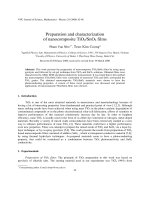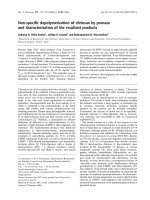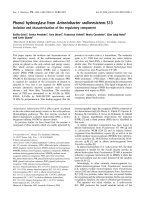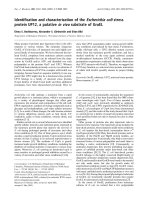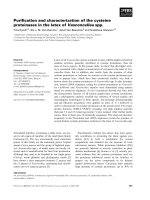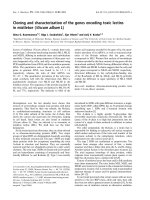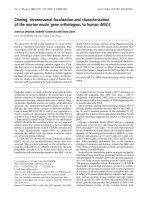Preparation and characterization of the PVDF-based composite membrane for direct methanol fuel cells
Bạn đang xem bản rút gọn của tài liệu. Xem và tải ngay bản đầy đủ của tài liệu tại đây (1.89 MB, 14 trang )
INTERNATIONAL JOURNAL OF
ENERGY AND ENVIRONMENT
Volume 1, Issue 4, 2010 pp.643-656
Journal homepage: www.IJEE.IEEFoundation.org
Preparation and characterization of the PVDF-based
composite membrane for direct methanol fuel cells
Qian Liu, Laizhou Song, Zhihui Zhang, Xiaowei Liu
Department of Environmental & Chemical Engineering, Yanshan University, Qinhuangdao 066004,
China.
Abstract
The polyvinylidene fluoride-sulfonated polystyrene composite membrane with proton exchange
performance, denoted as PVDF-SPS, was prepared using a thermally induced polymerization technique.
The thermal stability of the PVDF-SPS composite membrane was investigated using thermogravimetric
(TG) analysis. The complex formation of the composite membrane was ascertained by Fourier transform
infrared spectroscopy (FTIR). The surface compositions of the PVDF-SPS membrane were analyzed
using X-ray photoelectron spectroscopy (XPS). The morphology of the composite membrane was
characterized by environmental scanning electron microscopy (ESEM). The proton conductivity of the
PVDF-SPS membrane was measured using impedance spectroscopy in the hydrated condition. The
PVDF-SPS membrane has a stronger hydrophilic character than the pristine PVDF membrane and the
polyvinylidene fluoride-polystyrene composite membrane (PVDF-PS), which is caused by the
incorporation of sulfonic acid groups. The proton conductivity and the methanol permeability of the
PVDF-SPS membrane measured at 298 K are 29.3 mS.cm-1 and 8.6×10−8 cm2.s−1, respectively. Although
PVDF-SPS composite membrane possesses the lower oxidative stability than Nafion-117 membrane, the
composite membrane displays lower methanol permeability than the Nafion-117 membrane, and the
selectivity (the ratio of proton conductivity and methanol permeability) of the composite membrane is
almost 20 times than that of Nafion-117.
Copyright © 2010 International Energy and Environment Foundation - All rights reserved.
Keywords: Polyvinylidene fluoride-based composite membrane, Thermally induced polymerization,
Proton conductivity, Methanol permeability, Oxidative stability.
1. Introduction
The proton exchange membranes (PEMs) have played an important role in direct methanol fuel cells
(DMFCs). Membranes with high proton conductivity are potentially useful in electrochemical cells
including fuel cells. Normally, the widely used membranes in DMFCs are still perfluorinated
membranes, such as Nafion membranes, due to their high specific conductivity at room temperature, as
well as good mechanical and chemical stability. However, the cost and high methanol permeability are
the main difficulties for using them in DMFCs [1].
A number of studies have been performed with the goal of developing alternative membranes, focusing
on the reduction of the methanol permeability. Some of them have focused on developing new synthetic
polymeric membranes that have ionic clusters [2-11], and the modification of the Nafion membranes by
surface treatment or by blending them with other polymer/inorganic materials [12-21]. Polyvinylidene
ISSN 2076-2895 (Print), ISSN 2076-2909 (Online) ©2010 International Energy & Environment Foundation. All rights reserved.
644
International Journal of Energy and Environment (IJEE), Volume 1, Issue 4, 2010, pp.643-656
fluoride (PVDF) with excellent stability, is a kind of partial fluorinated polymer and has been widely
used in the battery field [22, 23]. It has been reported that PVDF-based composite membrane with nanosized ceramic powders could exhibit high proton conductivity when doped with some small molecular
weight acid [24]. Polyvinylidene fluoride grafted polystyrene sulfonated acid proton exchange
membranes based on a radiation-grafting technique were found that they have a higher proton
conductivity, water-uptake and lower methanol permeability compared to Nafion membranes [25].
In this work, based on the method of thermally induced polymerization and phase inversion technique
[26], the PVDF-based composite membrane (denoted as PVDF-SPS) with the performance of proton
conductivity was prepared. Styrene was used to be polymerized and blended with the PVDF polymer. A
kind of copolymer, polyvinylidene fluoride (PVDF)/sulfonated polystyrene (SPS) was adopted to prepare
the PVDF composite membrane. The structure and the morphology of the PVDF-SPS composite
membrane were characterized. The proton conductivity and the methanol permeability of the PVDF-SPS
composite membrane were also investigated.
2. Experimental
2.1 Materials
In the study, PVDF powders (reagent grade) were obtained from Chen Guang Chemical Plant (China).
Nafion-117 membrane with thickness of 230 µm, was provided by He Sen Electrical Plant (Shanghai,
China). The PVDF composite membrane was made in our laboratory using a combination technique of
thermally induced polymerization and phase inversion, and all of the other reagents were analytical
grade.
2.2 Preparation of the PVDF-based composite membrane
The PVDF powders were basified firstly, and the double bond was formed [27]. The PVDF powders
were dissolved in N, N-dimethylacetamide (DMAc) firstly, and then styrene, divinylbenzene (DVB) and
benzoyl peroxide (BPO) were added to the solution and stirred with water bath at 343 K. The dosage of
PVDF, styrene, DVB and BPO was that PVDF was 80 g.L-1, styrene acted as 140 ml.L-1, DVB was 7.5
ml.L-1, and BPO was 2 g.L-1, respectively. After the blending polymerization reaction, the polyvinylidene
fluoride/polystyrene copolymer were sulfonated in a ClSO3H acid/1,2-dichloroethane mixture at 313 K
for 4 h. When the solution was cooled to the room temperature, the solution was immersed in deionized
water for 48 h, and then the sulfonated copolymer washed with deionized water and dried for usage.
The sulfonated copolymer with weight of 15 g and 2.5 g polyvinyl pyrrolidine powders were dissolved in
100 mL DMAc. The mixture was heated at 343 K and stirred to obtain a viscous solution. After 2 h, the
cast solution was degassed in a water bath at 313 K for 6 h. The PVDF-based composite membrane was
prepared by a phase inversion process, and deionized water used as the non-solvent. The cast solution
was cast onto a clean glass plate, and a flexible composite membrane was obtained. The membrane was
washed several times with deionized water and then immersed in 0.5 mol.L-1 sulfuric acid solution for 24
h. The resulted membrane was washed with deionized water to remove the remaining sulfuric acid. The
final proton exchange membrane was denoted as PVDF-SPS. The thickness of the swelled membrane is
about 160 µm. The pristine PVDF membrane and the polyvinylidene fluoride/polystyrene membrane
(PVDF-PS) were prepared with the phase inversion method referring to our previous work [26, 28].
2.3 Structural characterization
The thermogravimetric analysis (TG) of the membranes were carried out by a STA 449C
thermogravimetric thermal analyzer under the dry argon atmosphere, and the samples were heated from
300 K to 973 K at a rate of 20 K.min−1. The FTIR spectra of the pristine PVDF membrane, PVDF-PS
membrane and the PVDF-SPS membrane were measured on E55+FRA106 FTIR spectrometer. Each
spectrum was collected by cumulating 16 scans at a resolution of 4 cm-1. The surface and cross-section
morphologies of the PVDF-SPS membrane were analyzed using the XL30 environmental scanning
electron microscopy (ESEM). VG ESCA250 X-ray photoelectron spectroscopy (XPS) was used to
characterize the elements of the PVDF-SPS composite membrane.
2.4 Water uptake
Water uptake is defined by (Wwet −Wdry)/Wdry, where Wdry is the weight of the sample membrane dried in
a vacuum oven under 373 K for 12 h and Wwet is the weight of the sample membrane saturated with
deionized water for 48 h and weighed immediately after removing surface water with filtration paper.
ISSN 2076-2895 (Print), ISSN 2076-2909 (Online) ©2010 International Energy & Environment Foundation. All rights reserved.
International Journal of Energy and Environment (IJEE), Volume 1, Issue 4, 2010, pp.643-656
645
2.5 Measurement of proton conductivity
The proton conductivity of the PVDF-SPS membrane and Nafion-117 membrane was measured using
the ac impedance technology. The sample of the given membrane was sandwiched between two stainless
steel electrodes. A spring loaded Teflon plunger was used to ensure an intimate contact between the end
of the probe and the membrane. The impedance tests were carried out in 105 Hz-10-2 Hz frequency range
at a maximum perturbation amplitude of 5 mV, using a Solartron 1250 Impedance Analyzer coupled
with a Solartron 1286 Electrochemical Interface. Before each measurement was carried out, the
membrane was equilibrated in deionized water for 12 h at ambient temperature. The measurements of
conductivity at high temperature were carried out in an oven. The proton conductivity of the membrane
(σ, S.cm-1) was calculated according to Eq. (1)
σ=
L
R⋅ A
(1)
where L is the membrane thickness between the two electrodes (cm), R is the membrane resistance (ohm)
and A is the cross-sectional area of membrane (cm2).
2.6 Methanol permeability
A two-reservoir cell was used for the measurement of methanol permeability at 298 K. The left reservoir
was filled with an aqueous solution of 1 mol.L-1 methanol, while the right reservoir was filled with
deionized water. The two reservoirs had a circularly symmetrical transport channel with the membranes
separated between them. The methanol flux was established across the membrane driven by the
concentration difference between the two reservoirs. The change of methanol concentration with time in
the right reservoir was measured using a gas chromatographic instrument (Agilent 6890N, USA). The
methanol permeability of the membrane was then calculated using Eq. (2)
P=
VB L
×α
AC A
(2)
where CA is the methanol concentration in the feed compartment (mol.L-1). VB is the volume of right
reservoir (cm3). A and L are the membrane cross-sectional area and thickness, respectively. α is the slope
of the linear plot of methanol concentration in the right reservoir (CB) versus time t.
2.7 Oxidative stability
The oxidative stability was investigated by measuring the weight change of the membrane with a size of
3cm × 3cm, and the membrane was immersed in 3wt.% H2O2 aqueous solution at 333K. Every 12 h, the
sample was taken out and the excessive surface water was quickly wiped with a tissue paper. The weight
of the membrane was measured using an electronic balance immediately. The stability of the membrane
was evaluated using the reduction of its weight.
3. Results and discussion
3.1 Thermal analysis of the PVDF-SPS composite membrane
The TG analysis curve is presented in Figure 1 for the investigation of the thermal stability of the PVDF
membrane, PVDF-PS membrane, and the PVDF-SPS composite membrane. For the pristine PVDF
membrane (curve Figure 1a), the PVDF polymer is stable up to about 630 K and suffers a weight loss of
less than 5 % at 673 K [28]. The PVDF-PS membrane is thermally stable up to about 610 K (curve
Figure 1b), and the last weight loss step at temperatures above 710 K corresponds to the bulk
decomposition of the PVDF polymer. The PVDF-SPS membrane (curve Figure 1c) shows intermediate
weight loss behavior in comparison to that of the pristine PVDF membrane (curve Figure 1a) and the
PVDF-PS composite membrane (curve Figure 1b). A distinct two-step degradation process is observed
for the PVDF-SPS sample. The onset of the first major weight loss at about 520 K corresponds to the
decomposition of the PS polymer component. The second major weight loss commences at about 710 K,
corresponding to the decomposition of the PVDF main chains [28].
ISSN 2076-2895 (Print), ISSN 2076-2909 (Online) ©2010 International Energy & Environment Foundation. All rights reserved.
646
International Journal of Energy and Environment (IJEE), Volume 1, Issue 4, 2010, pp.643-656
100
Weight remaining/%
(c)
(a)
(b)
80
60
40
20
0
0
140
280
420
560
700
o
Temp./ C
Figure 1. TG curve of the membranes: (a) PVDF, (b) PVDF-PS, (c) PVDF-SPS
3.2 FTIR spectra of the PVDF-SPS composite membrane
In order to investigate the complex formation in the PVDF-SPS membrane, FTIR studies have been
carried out. FTIR spectra of the pristine PVDF membrane, the PVDF-PS membrane and the PVDF-SPS
membrane are shown in Figure 2. The absorption peaks appearing at 3025 cm-1, 471 cm-1 and 1200 cm-1
are assigned to CF stretching, CF wagging, and CF bending vibration modes of PVDF [28]. The peak at
1200 cm-1 is found to be weak in the PVDF-based composite membranes. Blending of styrene is
confirmed by the presence of aromatic ring features at 1493 and 1602 cm−1 corresponding to the presence
of skeletal C=C in plate stretching vibrations [25]. A characteristic peak of a mono-substituted benzene
ring is also shown at 750 cm−1. The peak at 699 cm−1, shown in Figure 2b and 2c, originates from the
benzene groups of PS [29]. In the PVDF-SPS membrane, as shown in Figure 2c, the new peak appearing
at 1126 cm−1 corresponds to the vibrations of the sulfonic acid groups (—SO3H) attached to the benzene
rings, and the peak at 1007 cm−1 corresponds to those of the benzene groups containing the sulfonic acid
groups [30, 31]. The broad peak at 3410 cm−1 is assigned to the —OH species of water molecules that are
involved in hydrogen bonding with the —SO3- groups [30, 32]. The FTIR spectra showed that the PVDFSPS proton exchange membrane was prepared successfully.
(c)
750cm
-1
Transmittance/%
1602cm
3025cm
-1
3410cm
-1
-1
-1
-1
699cm
1493cm
-1
-1
1007cm
471cm
-1
1126cm
750cm
1602cm
-1
1200cm
-1
1493cm
(b)
3025cm
-1
-1
-1
(a)
3025cm
471cm
0
-1
-1
800
1600
2400
3200
4000
-1
Wave number/cm
Figure 2. FTIR spectra of the membranes: (a) PVDF, (b) PVDF-PS, (c) PVDF-SPS
ISSN 2076-2895 (Print), ISSN 2076-2909 (Online) ©2010 International Energy & Environment Foundation. All rights reserved.
International Journal of Energy and Environment (IJEE), Volume 1, Issue 4, 2010, pp.643-656
647
3.3 XPS analysis of the PVDF-SPS composite membrane
The surface compositions of the PVDF-SPS composite membrane are investigated using XPS
measurements (Figure 3). Figure 3a, Figure 3b and Figure 3c show the C1s core-level spectra, O1s corelevel spectra and S2p core-level spectra of the PVDF-SPS membrane, respectively.
The C1s core-level spectrum of the PVDF-SPS membrane can be curve-fitted with four peak components,
with binding energies at 285.8 eV for the CH2 species, and at 290.43 eV for the CF2 species [26, 28], the
component peak at 286.44 eV is assigned for aliphatic C—H species of the polystyrene chain blended to
the PVDF polymer. The peak with BE of 288.06 eV is attributed to C—S species which is in sulfonic
acid group. In the XPS spectra of the PVDF-SPS membrane, The O1s peak and the S2p peak of the
composite membrane appeared at 532.47 eV and 169 eV, respectively [30, 32]. It can be inferred that the
sulfonated polystyrene polymer was blended to PVDF membrane completely, and the sulfonic acid
functional group was grafted to the PVDF membrane.
30000
(a)
285.8ev
Intensity/CPS
25000
20000
15000
286.44ev
290.43ev
10000
288.06ev
5000
0
296
292
288
284
280
Binding energy/eV
(a)
4500
(b)
532.47ev
Intensity/CPS
4000
3500
3000
540
536
532
528
524
Binding Energy(ev)
(b)
ISSN 2076-2895 (Print), ISSN 2076-2909 (Online) ©2010 International Energy & Environment Foundation. All rights reserved.
648
International Journal of Energy and Environment (IJEE), Volume 1, Issue 4, 2010, pp.643-656
6000
169eV
(c)
Intensity/CPS
5400
4800
4200
3600
3000
180
176
172
168
164
Binding energy/eV
160
(c)
Figure 3. XPS spectra of the PVDF-SPS membrane: (a) C1s, (b) O1s, (c) S2p
3.4 Morphology of the PVDF-SPS composite membrane
The morphologies of the pristine PVDF membrane, the PVDF-PS membrane and the PVDF-SPS
membrane were revealed by ESEM. SEM surface and cross-section micrographs of the membranes are
shown in Figure 4. It is clearly seen from Figure 4a to Figure 4c, that the pristine PVDF membrane has
the larger pores than the PVDF-PS membrane and the PVDF-SPS membrane. The mean pore diameter of
the PVDF membrane, the PVDF-PS membrane and the PVDF-SPS membrane is 0.25 µm, 0.12 µm and
0.16 µm, respectively. It can be seen that the polymerization of styrene and the blending of PS and SPS
polymers have affected the surface structure of the PVDF membrane obviously. The cross-section
morphologies of the PVDF membrane, the PVDF-PS membrane and the PVDF-SPS membrane are
shown in Figure 4d, Figure 4e and Figure 4f, respectively. Using water as the coagulant, as can been
seen, Figures 4d - 4f show that the long finger-like structures with small pore opening are present under
the outer skin layer of the membranes, and the sponge-like structures appear in the inner part of the
membranes. As shown in Figure 4e, many big aggregates appear in the middle part of the PVDF-PS
membrane. The hydrophobic property of PS polymer promoted the formation of these polymer
aggregates.
As can be seen, the thermally induced polymerization of styrene, as well as the blending of PS and SPS
polymers, causes reduction in the remaining pores of the PVDF membrane overwhelmingly. It also
reduces the mean pore diameter on the surface of the PVDF membrane. It also can be seen that the
structure of PVDF-SPS membrane appears a uniform pore size distribution with no distinction between
the sulfonated polystyrene polymer and the PVDF matrix.
3.5 Water uptake of the PVDF-SPS composite membrane
Table 1 shows the water uptake of the pristine PVDF membrane, the PVDF-PS membrane and the
PVDF-SPS composite membrane. The blending of PS polymer reduces the water uptake of the PVDF
membrane decreasing from 22.05% to 14.31%, which can explain the hydrophobic property of PS
polymer. However, the water uptake of PVDF-SPS membrane is larger than that of the pristine PVDF
membrane, which is caused by the hydrophilicity of the sulfonated polystyrene (SPS) polymer. The SPS
polymer helps promote the liquid retention in the PVDF membrane due to it property of hydrophilicity. It
has been shown that the SPS polymer absorbs water on the surface through a strong interaction with
surface —SO3- groups and formation of hydrogen bonds, which increases the water retention.
ISSN 2076-2895 (Print), ISSN 2076-2909 (Online) ©2010 International Energy & Environment Foundation. All rights reserved.
International Journal of Energy and Environment (IJEE), Volume 1, Issue 4, 2010, pp.643-656
649
(a)
(b)
(c)
ISSN 2076-2895 (Print), ISSN 2076-2909 (Online) ©2010 International Energy & Environment Foundation. All rights reserved.
650
International Journal of Energy and Environment (IJEE), Volume 1, Issue 4, 2010, pp.643-656
(d)
(e)
(f)
Figure 4. SEM micrographs of the membranes: (a - c) surface micrograph of PVDF, PVDF-PS, PVDFSPS respectively; (d - f) cross-section of micrograph of PVDF, PVDF-PS, PVDF-SPS respectively
ISSN 2076-2895 (Print), ISSN 2076-2909 (Online) ©2010 International Energy & Environment Foundation. All rights reserved.
International Journal of Energy and Environment (IJEE), Volume 1, Issue 4, 2010, pp.643-656
651
Table 1. Water uptake of the membranes
Membrane
PVDF
PVDF-PS
PVDF-SPS
Water uptake /%
22.05
14.31
49.22
3.6 Proton conductivity of the PVDF-SPS composite membrane
Figure 5 shows the conductivity of the PVDF-SPS membrane and Nafion-117 membrane at the different
temperatures. It can be seen that the relationship of log (σ) and the parameter 1000/T satisfies an
Arrhenius equation [29]. The conductive active energy (Ea) of the membranes were calculated, 18.58
kJ.mol−1 for Nafion-117 and 20.05 kJ.mol−1 for PVDF-SPS membrane, respectively. Ea of the PVDFSPS membrane is close to that of the Nafion-117. The proton conductivity of the PVDF-SPS membrane
and Nafion-117 is 29.3 mS.cm-1 and 54.3 mS.cm-1 at 298 K, respectively. It indicates that the proton
conductivity performance of the PVDF-SPS membrane is good, although the proton conductivity of
PVDF-SPS membrane is smaller than that of the commercial Nafion-117 membrane.
-1.0
-1.2
Logσ/S.cm
-1
(b)
-1.4
(a)
-1.6
-1.8
2.8
2.9
3.0
3.1
3.2
-1
1000/T(K )
3.3
3.4
Figure 5. Relationship of the proton conductivity in the PVDF-SPS membrane (a), and in the Nafion-117
membrane (b) with temperature
3.7 Methanol permeability of the PVDF-SPS composite membrane
The variation of methanol concentration in the permeate compartment (CB) with the time for PVDF-SPS
membrane and Nafion-117 membrane were measured. Figure 6 shows that the two kind of membranes
report a linear relationship between CB and t, and the methanol permeability of the membranes can be
calculated from the slopes of the linear curves according to Eq. (2). The methanol permeability of the
PVDF-SPS membrane was measured to be 8.6×10−8 cm2.s−1, and the methanol permeability of Nafion117 was 3.4×10−6 cm2.s−1 under the same conditions. Compared with the Nafion-117, the PVDF-SPS
membrane shows a better performance in restraining the methanol permeability.
As the proton conductive membranes of the direct methanol fuel cells, they must have both excellent
proton conductivity and low methanol permeation. However, sometimes these have been mutually
incompatible. In order to compare the comprehensive character of the membranes, the ratio of proton
conductivity and methanol permeability, defined as the selectivity, was calculated. The selectivity of
PVDF-SPS membrane was calculated to be 3.41×105 S.s.cm−3, which is almost 20 times than that of
Nafion-117 membrane.
ISSN 2076-2895 (Print), ISSN 2076-2909 (Online) ©2010 International Energy & Environment Foundation. All rights reserved.
652
International Journal of Energy and Environment (IJEE), Volume 1, Issue 4, 2010, pp.643-656
10
10
PVDF-SPS
Nafion-117
CB/mmol.L-1
8
8
6
6
4
4
2
2
0
0
0
30
60
90
120
150
180
t/min
Figure 6. Variation of the methanol concentration in the permeate compartment (CB) with time for
PVDF-SPS membranes and Nafion-117 membrane
3.8 Oxidative stability of the PVDF-SPS composite membrane
Oxidative stability of proton exchange membranes is one of the most important factors that affect
membrane durability. It is known that the possible degradation of polymer electrolyte is caused during
fuel cell operation. In this study, the oxidative stability of the membranes were investigated in a 3% H2O2
aqueous solution at 333 K. Figure 7 shows the weight change of Nafion-117 membrane and the PVDFSPS composite membrane. The Nafion-117 membrane showed high stability, flexibility without any
changes in appearance after the testing for 180 h. As show in Figure 7, it was found that the weight of
PVDF-SPS composite membrane initially increases and then decreases, and there is a peak in the curve
at 60 h. The PVDF-SPS membrane continuously swells and decomposes. The swelling is due to the
degradation of the cross-linking structure of the membrane in the H2O2 solution [33]. The decomposition
rate is larger than the swelling effect after 60 h. The result indicates that the stability of PVDF-SPS
membrane is lower than that of Nafion-117 membrane.
1.4
10
Nafion-117
PVDF-SPS
Weight /%
1.2
8
6
4
1.0
2
0.8
0
0
40
80
120
160
200
time/h
Figure 7. Oxidative stability of Nafion-117 membrane and PVDF-SPS membrane in the 3%H2O2
solution at 333 K
ISSN 2076-2895 (Print), ISSN 2076-2909 (Online) ©2010 International Energy & Environment Foundation. All rights reserved.
International Journal of Energy and Environment (IJEE), Volume 1, Issue 4, 2010, pp.643-656
653
4. Conclusions
The PVDF-based composite membrane has been prepared using a simultaneous thermally induced
polymerization and blending technique. Polystyrene and the sulfonated polystyrene polymers are blended
into the PVDF polymer. Using the polyvinylidene fluoride-sulfonated polystyrene copolymer, the PVDFSPS composite membrane with the performance of proton conductivity, has been prepared simply.
FTIR and XPS results confirm that the polystyrene and the sulfonated polystyrene polymers are blended
into the PVDF matrix. SEM result shows that the PVDF-SPS composite membrane has a more uniform
pore size distribution than the pristine PVDF membrane. The PVDF-SPS membrane has a strong
hydrophilic character that is caused by the incorporation of sulfonic acid groups. The PVDF-SPS
composite membrane displays lower methanol permeability than the Nafion-117 membrane. The
selectivity of the PVDF-SPS composite membrane is almost 20 times than that of Nafion-117. However,
the PVDF-SPS composite membrane possesses lower oxidative stability than Nafion-117 membrane, and
the further research on increasing the anti-oxidation performance of PVDF-SPS composite membrane
should be done.
The overall findings suggest that the PVDF-SPS membrane offers the potential for improving the
performance of the DMFCs, this kind of membrane may still have the promising applications in DMFCs.
References
[1] Prakash G K S, Smart M C, Wang Q J, Atti A, Pleynet V, Yang B, et al. High efficiency direct
methanol fuel cell based on poly(styrenesulfonic) acid (PSSA)–poly(vinylidene fluoride) (PVDF)
composite membranes. J. Fluorine Chem, 2004, 125(8):1217-1230.
[2] Gil M, Ji X L, Li X F, Na H, et al. Direct synthesis of sulfonated aromatic poly(ether ether
ketone) proton exchange membranes for fuel cell applications. J. Membr. Sci, 2004, 234(12): 75-81.
[3] Xianfeng Li, Changpeng Liu, Hui Lu, et al. Preparation and characterization of sulfonated
poly(ether ether ketone ketone) proton exchange membranes for fuel cell application. J. Membr.
Sci, 2005, 255(1-2):149-155.
[4] V.S. Silva, A. Mendes, L.M. Madeira, et al. Proton exchange membranes for direct methanol fuel
cells: Properties critical study concerning methanol crossover and proton conductivity. J. Membr.
Sci, 2006, 276(1-2):126-134.
[5] Rikukawa M, Sanui K. Proton-conducting polymer electrolyte membranes based on hydrocarbon
polymers. J. Prog. Polym. Sci, 2000, 25(10): 1463-1502.
[6] Kim Y S, Hickner M A, Dong L M, Pivovar B S, McGrath J E. Sulfonated poly(arylene ether
sulfone) copolymer proton exchange membranes: composition and morphology effects on
the methanol permeability. J. Membr. Sci, 2004, 243(1-2): 317-326.
[7]
[8]
[9]
[10]
[11]
[12]
[13]
Wang F, Hickner M, Kim Y S, et al. Direct polymerization of sulfonated poly(arylene ether
sulfone) random (statistical) copolymers: candidates for new proton exchange membranes. J.
Membr. Sci, 2002; 197(1-2): 231-242.
Scott K, Taama W M, Argyropoulos P. Performance of the direct methanol fuel cell with
radiation-grafted polymer membranes. J. Membr. Sci, 2000; 171(1): 119-130.
Elomaa M, Hietala S, Paronen M, et al. The state of water and the nature of ion clusters in
crosslinked proton conducting membranes of styrene grafted and sulfonated poly(vinylidene
fluoride). J. Mater. Chem. 2000, 10(12): 2678-2684.
Yamaguchi T, Miyata F, Nakao S-i. Pore-filling type polymer electrolyte membranes for a direct
methanol fuel cell. J. Membr. Sci, 2003, 214(2): 283-292.
Akiko Yamauchi, Taichi lto, Takeo Yamaguchi. Low methanol crossover and high performance of
DMFCs achieved with a pore-filling polymer electrolyte membrane. J. Power Sources, 2007,
174(1): 170-175.
Jung D H, Cho S Y, Peck D H, Shin D R, Kim J S. Performance evaluation of a Nafion/silicon
oxide hybrid membrane for direct methanol fuel cell. J. Power Sources, 2002, 106(1-2): 173177.
Panero S, Ciuffa F, D’Epifano A, Scrosati B. New concepts for the development of lithium
and proton conducting membranes. Electrochim. Acta, 2003, 48(14-16): 2009-2014
ISSN 2076-2895 (Print), ISSN 2076-2909 (Online) ©2010 International Energy & Environment Foundation. All rights reserved.
654
International Journal of Energy and Environment (IJEE), Volume 1, Issue 4, 2010, pp.643-656
[14] Ronghuan He, Qingfeng Li, Gang Xiao, Niels J.Bjerrum. Proton conductivity of phosphoric acid
doped polybenzimidazole and its composites with inorganic proton conductors. J. Membr. Sci,
2003, 226(1-2):169-184
[15] C. W. Lin, K. C. Fan, R. Thangmuthu. Preparation and characterization of high selectivity organicinorganic hybrid –laminated Nafion 115 membranes for DMFC. J. Membr. Sci, 2006, 278(12):437-446
[16] Dimitrova P, Friedrich K A, Vogt B, Stimming U. Transport properties of ionomer composite
membranes for direct methanol fuel cells. J. Electroanal. Chem, 2002, 532(1-2): 75-83.
[17] Hüseyin Deligöz, Serpil Yilmaztürk, Tuba Karaca, et al. Self-assembled polyelectrolyte
multilayered films on Nafion with lowered methanol cross-over for DMFC applications. J.
Membr. Sci, 2009, 326(2): 643-649.
[18] Z. Q.Ma, P. Cheng, T. S.Zhao. A palladium-alloy deposited Nafion membrane for direct methanol
fuel cells. J. Membr. Sci, 2003, 215(1-2): 327-336.
[19] Hobson L J, Nakano Y, Ozu H, Hayase S. Targeting improved DMFC performance. J. Power
Sources, 2002, 104(1): 79-84.
[20] Walker M, Baumgärtner K-M, Feichtinger J, et al. Barrier properties of plasma-polymerized thin
films. Surf. Coat. Technol. 1999; 116–119: 996-1000.
[21] Hobson L J, Ozu H, Yamaguchi M, Hayase S. Modified Nafion 117 as an improved polymer
electrolyte membrane for direct methanol fuel cells. J. Electrochem. Soc. 2001, 148(10): 11851190.
[22] Chen N P, Hong L. Embedding poly(styrene sulfonic acid) into PVDF matrix-a new type of
proton electrolyte membrane. Polymer, 2004, 45(7): 2403-2411.
[23] Prakash G K S, Smart M C, Wang Q J, Atti A, Pleynet V, Yang B, et al. High efficiency direct
methanol fuel cell based on poly(styrenesulfonic) acid (PSSA)–poly(vinylidene fluoride)
(PVDF) composite membranes. J. Fluorine Chem, 2004, 125(8): 1217-1230.
[24] Duvdevani T, Philosoph M, Rakhman M, Golodnitsky D, Peled E. Novel composite protonexchange membrane based on silica-anchored sulfonic acid (SASA). J. Power Sources, 2006,
161(2):1069-1075.
[25] Nasef M M, Zubir N A, Ismail A F, et al. Preparation of radiochemically pore-filled polymer
electrolyte membranes for direct methanol fuel cells. J. Power Sources, 2006, 156(2): 200-210.
[26] Song L Z, Dong C Y, Li J. Application of the PAA-PVDF microfiltration composite membrane for
municipal wastewater advanced treatment. Toxicological and Environmental Chemistry, 2007,
89(2): 223-232.
[27] Kise H, Ogata H. Phase transfer catalysis in dehydrofluorination of Poly (vinylidene fluoride) by
aqueous sodium hydroxide solutions. J. Polym. Sci.: Polym. Chem, 1983, 21: 3443-3451.
[28] Song L Z, Zhang Z J, Song S Z, Gao Z M. Preparation and characterization of the modified
polyvinylidene fluoride (PVDF) hollow fibre microfiltration membrane. J. Mater. Sci. Technol,
2007, 23(1): 55-60.
[29] Shen Y, Qiu X P, Shen J, Xi J Y, Zhu W T. PVDF-g-PSSA and Al2O3 composite proton
exchange membranes. J. Power Sources, 2006, 161(1): 54-60.
[30] Bae B, Ha H Y, Kim D. Nafion®-graft-polystyrene sulfonic acid membranes for direct
methanol fuel cells. J. Membr. Sci, 2006, 276(1-2): 51-58.
[31] Amarilla J M, Rojas R M, Rojo J M, et al. Antimonic acid and sulfonated polystyrene protonconducting polymeric composites. Solid State Ionics, 2000, 127(1-2): 133-139.
[32] Huslage J, Rager T, Schnyder B, Tsukada A. Radiation-grafted membrane/electrode assemblies
with improved interface. Electrochim. Acta, 2002, 48(3): 247-254.
[33] Rong-Qiang Fu, Jung-Je Woo, Seok-Jun Seo, et al. Sulfonated polystyrene/polyvinyl chloride
composite membranes for PEMFC applications. J. Membr. Sci, 2008, 309(1-2):156-164.
ISSN 2076-2895 (Print), ISSN 2076-2909 (Online) ©2010 International Energy & Environment Foundation. All rights reserved.
International Journal of Energy and Environment (IJEE), Volume 1, Issue 4, 2010, pp.643-656
655
Qian Liu: a post graduate majoring in environmental engineering in Yanshan University situated in
Qinhuangdao, China. Wastewater treatment is her current study field.
E-mail address:
Laizhou Song: the corresponding author, a professor in Yanshan University with a ph.D in applied
chemistry. He is engaged in the wastewater treatment and new energy application, and has published some
related articles and patents in this field.
E-mail address: ; Tel: 86-335-8061569.
Zhihui Zhang: a post graduate majoring in environmental engineering in Yanshan University situated in
Qinhuangdao, China. Wastewater treatment is his current study field.
E-mail address:
Xiaowei Liu: a post graduate majoring in environmental engineering in Yanshan University. Wastewater
treatment is his current study interest.
E-mail address:
ISSN 2076-2895 (Print), ISSN 2076-2909 (Online) ©2010 International Energy & Environment Foundation. All rights reserved.
656
International Journal of Energy and Environment (IJEE), Volume 1, Issue 4, 2010, pp.643-656
ISSN 2076-2895 (Print), ISSN 2076-2909 (Online) ©2010 International Energy & Environment Foundation. All rights reserved.

